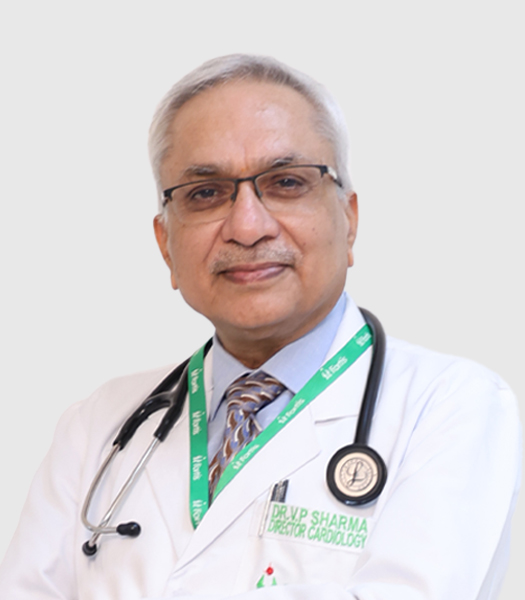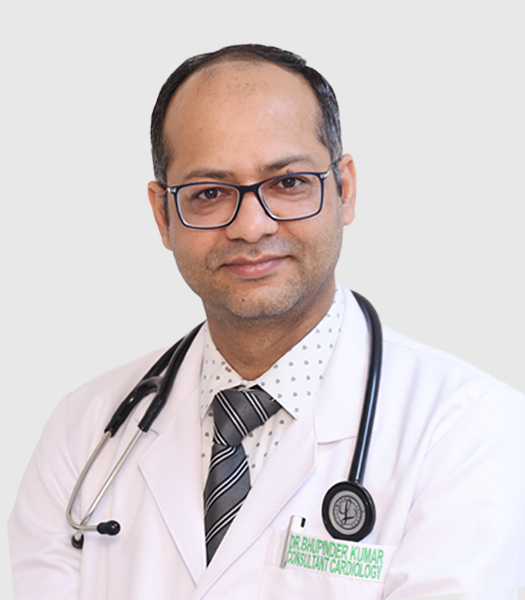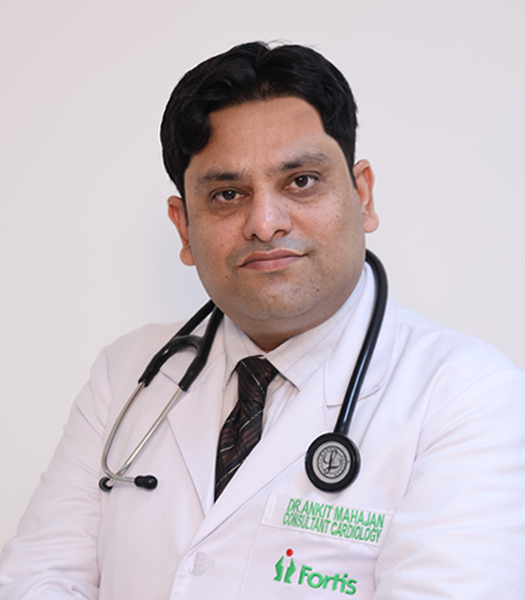Cardiology

Cardiology is the medical speciality dealing with the diagnosis and treatment of diseases and disorders of the heart. The Cardiology Department at Shrimann Superspeciality Hospital is Centre of Excellence and is headed by Dr. V.P. Sharma who has more than 30 years of experience. He is assisted by 3 cardiologists in his team Dr. Bhupinder Kumar, Dr.Ruhani Bali, Dr.Peerzadi Shabeena. Department has a team of well-trained and experienced cardiac care and cath lab technicians and staff nurses.
The Cardiology department is equipped with the state of the art Siemens Cath lab and patients are observed in a well equipped 18 bedded ICCU & PCU.
The various facilities available in the cardiology department are:
1. NON INVASIVE CARDIOLOGY
Non-invasive cardiology identifies heart problems without using anyneedles, fluids, or other instruments which are inserted into the body.
TREADMILL TEST
The TREADMILL TEST (TMT) is a test used in medicine and cardiology to measure the heart's ability to respond to external stress in a controlled clinical environment.
The cardiac stress test is done with heart stimulation, either by exercise on a treadmill, pedalling a stationary exercise bicycle ergometer or with intravenous pharmacological stimulation, with the patient connected to an Electrocardiogram(or ECG).
The cardiac stress test is done with heart stimulation, either by exercising on a treadmill, pedalling a stationary exercise bicycle ergometer or with a intravenous pharmacological stimulation, with thepatient connected to an Electrocardiogram(or ECG). The level of mechanical stress is progressively increased by adjusting the difficulty (steepness of the slope) and speed. The test administrator or attending physician examines the symptoms andblood pressure response. With the use of ECG, the test is mostcommonly called a cardiac stress test, but is known by other names,such as exercise testing, stress testing treadmills, exercise tolerance test, stress test or stress test of ECG.
ECHOCARDIOGRAPHY
Echocardiography is a test that uses sound waves to produce liveimages of your heart. The image is an echocardiogram. This test allows your doctor to monitor how your heart and its valves are functioning.The images can help them spot:
Blood clots in the heart.
Fluid in the sac around the heart.
Problems with the aorta, which is the main artery connected to the heart.
HOLTER MONITORING
A Holter monitoring is a battery-operated portable device that measures and records your heart's activity(ECC) continuously for 24 to 48 hoursor longer depending on the type of monitoring used. The device is the size of a small camera. It has wires with silver one rupee coin sized electrodes that attach to your skin. The Holter monitor and other devices that record your ECG as you go about your daily activities are called ambulatory electrocardiograms.
ECG
An electrocardiogram (ECG) is a medical test performed to detect heart abnormalities by measuring the electrical activities of the heart.
AN ECG IS RECOMMENDED
As part of the general examination of the heart
To determine the cause of chest pain, breathlessness, dizziness, fainting or rapid, irregular heartbeats (palpitations)
To assess how medications or medical devices(such aspacemakers) help keep the disease in control
To check the health of the heart when other conditions that affect the heart are present (such as a high blood pressure, a high levelof cholesterol, diabetes, smoking or a family history of heart diseases)
ABPM
Ambulatory Blood Pressure Monitoring (ABPM) is when your blood pressure is being measured as you move around, living your normalit is normally carried over 24 hours. It uses a small digital blood pressure machine that is attached to a belt around your bodyand which is connected to a cuff around your upper arm. It small enough that you can go about your normal daily life and even sleepwith it on.
TEE
Transesophageal echocardiography (TEE) is a test that produces pictures of your heart. TEE uses high-frequency sound waves (ultrasound) to make detailed pictures of your heart and the arteries that lead to and from it. Unlike a standard echocardiogram, the echotransducer that produces the sound waves for TEE is attached to a thintube that passes through your mouth, down your throat and into youresophagus. Because the esophagus is so close to the upper chambers ofthe heart, very clear images of those heart structures and valves can beobtained.
STRESS ECHO
A stress Echocardiography also called an echocardiography stress testor stress echo is a procedure that determines how well your heart andblood vessels are working.
During a stress echocardiography, you'll exercise on a treadmill or stationary bike while your doctor monitors your blood pressure and heart rhythm. When your heart rate reaches peak levels, your doctor will take ultrasound images of your heart to determine whether your heart muscles are getting enough blood and oxygen while your Exercise.
2. INVASIVE CARDIOLOGY
Invasive cardiology uses open or minimally-invasive surgery to identify or treat structural or electrical abnormalities within the heart structure.
CORONARY ANGIOGRAPHY
Coronary angiography involves the study of coronary arteries which supply the heart. It is done by injecting a dye into a peripheral artery.
CORONARY ANGIOPLASTY
It is the procedure of opening blocked coronary arteries and placing a stent.
CAROTID ANGIOGRAPHY AND ANGIOPLASTY
Carotid angiography is an invasive imaging procedure that involves inserting a catheter into a blood vessel in the arm or leg and guiding it to the carotid arteries with the aid of a special x-ray machine.
ALL PERIPHERAL ANGIOGRAPHY
A peripheral angiography is a test that uses x-rays and dye to help your doctor find narrowed or blocked areas in one or more of the arteries that supply blood to your legs. The test is also called peripheral arteriogram.
BIVENTRICULAR ICD
A biventricular (ICD) pacemaker is a special pacemaker used for cardiac re-synchronisation therapy in heart failure patients. In a normal heart, the heart's lower chambers (ventricles) pump atthe same time and in sync with heart's upper chambers (atria) When a person has heart failure, often the right and left ventricle do not pump together. When the heart contractions become out of sync, the the left ventricle is not able to pump enough blood to the body. This eventually leads to an increase in heart failure symptoms, such as shortness of breath, dry cough, swelling in the ankles or legs, weight gain, increased urination, fatigue, or rapid or irregular heartbeat.
AICD
An automatic implantable cardioverter defibrillator (AICD) is a small device, made up of a wire and body, used to continuously check your heart beat. AICDS are extraordinary machines designed to help the pace of the heart and to deliver a shook if needed. Overall, such devices can speed up or slow down your heart rate, with the ultimate goal of keeping your heart beat as normal as possible.
BIVENTRICULAR PACING/CRT
CRT or biventricular pacing is a special type of pacemaker for certain patients with heart failure; it is used to recover the heart's rhythm and treat the symptoms related to Arhythmia. CRT can be equally effective for both men and women.
The procedure companies of implanting a small pacemaker, usually just below the collarbone. The entrenched device paces both the left and right ventricles (both lower chambers, hence also called Bi-Ventricular pacemaker) of the heart concurrently. Three wires(leads) attached to the device monitor the heart rate to identify heart rate abnormalities and procedure tiny pulses of electricity to rectify them. In simple terms, it is a resynchronising the destabilised heart to improve its effectiveness.
PERMANENT PACEMAKER IMPLANTATION
Permanent Pacemaker implantation (PPI) may be in the form of single chamber (WI; WIR) pacemaker implantation, Dual chamber(DDD, PDDR) pacemaker implantation and cardiac resynchronisation therapy(CRT).
Permanent pacemaker implantation involves placement of a single wire or lead (single chamber PPI) into the Right ventricular chamber of the heart(WI; WIR) or two wires or leads (Dual chamber PPI), one each into the Right ventricle and the Right atrial chamber of the heart(DDD; DDDR). The entire procedure is done under local anaesthesia and the patient is conscious during the procedure.
BMV, PMV
BMV,PMV.Percutaneous Balloon Mitral Valvuloplasty (PBMV) is aprocedure to dilate the mitral valve in the setting of rheumatic mitralvalve stenosis. A catheter is inserted into the femoral vein, advanced to the right atrium and across the interatrial septum. Then the mitralvalve is crossed with a balloon and it is inflated to relieve the fusion ofthe mitral valve commissures effectively acting to increase the mitralvalve area and reduce the degree of mitral stenosis. Mitralregurgitation is contraindicated if moderate or severe via Echocardiography to assess the likelihood of using PBMV based on certain echocardiographiccriteria.
PERIPHERAL EMBOLECTOMY
Embolectomy is the emergency surgical removal of emboli which are blocking blood circulation. Embolectomy is an emergency procedure often as the last resort because permanent occlusion of a significant blood flow to an organ leads to necrosis. Other involved therapeutic options are anticoagulation and thrombolysis.
DEVICE CLOSURE- FOR ASD,VSD & PDA
ASD, VSD and PDA are birth defects. Now with device closure procedures, we close these defects without any major open heart surgery and the patient can be discharged the next day.
EP STUDY WITH RF ABLATION
An electrophysiology study is a test to measure the electrical activities of the heart and to diagnose an arrhythmia or abnormal heart rhythm of arrhythmia. Both are safe procedures.



